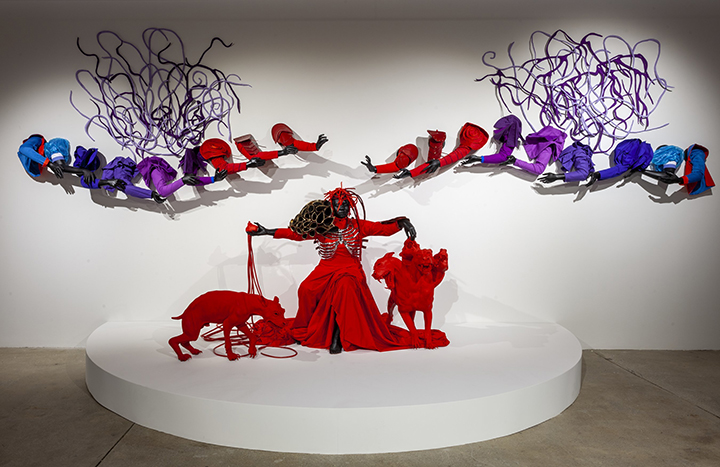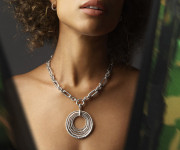The Museum of Arts and Design (MAD) will present Garmenting: Costume as Contemporary Art, the first global survey exhibition dedicated to the use of clothing as a medium of visual art. On view March 12 to August 14, 2022, the exhibition examines work by thirty-five international contemporary artists, from established names to emerging voices, several of whom will be exhibiting for the first time in the United States. By either making or altering clothing for expressive purposes, these artists create garments, sculpture, installation, and performance art that transforms the dress into a critical tool for exploring issues of subjectivity, identity, and difference.

Mary Sibande, The Domba Dance, 2019. Courtesy the artist and Kavi Gupta, Chicago. Photo – John Lusis ©
The exhibition is guest curated by Alexandra Schwartz, a New York-based art historian, curator, and adjunct professor in the School of Graduate Studies at SUNY | Fashion Institute of Technology. Schwartz remarked, “Despite the current ubiquity of garmenting as a visual arts practice, it has not previously been examined or theorized. This exhibition centers contemporary artists’ exploration of dress as a formal trope and critical tool, using the language of fashion to address fundamental aspects of subjectivity, including gender, class, race, and ethnicity.”
“Garmenting furthers MAD’s mission to connect handcraft and design to the global contemporary art world,” said Elissa Auther, Deputy Director of Curatorial Affairs and William and Mildred Lasdon Chief Curator. “The artists brought together share objectives of upending tired distinctions between the fine and applied arts, creating work that explores the essential relationship between the body and the garments that adorn it.”
Spanning two floors of the Museum, Garmenting is organized around five interrelated themes.
FUNCTIONALITY
One of the major issues with which garmenting engages in the traditional divide between the fine and applied arts. Garmenting offers a critique of this division by questioning what makes a garment “functional” (i.e., wearable in everyday life) versus “art” (i.e., for exhibition or performance).
GENDER
Clothing is intimately intertwined with the construction of gender. Influenced by feminist and queer theory, many artists use garmenting to look critically at the construction—and disruption—of gender identities.
ACTIVISM
Artists have long practiced garmenting as an activist gesture, deploying the symbolism inherent in dress—particularly in relation to gender, sexuality, and cultural difference—to help advance a political agenda.
CULTURAL DIFFERENCE
Historically, the dress was primarily determined by cultural identifiers such as ethnicity, region, religion, and class. Many of these markers have been eroded by industrialization and globalization. Artists in this section use the vocabulary of dress to combat threats to, help preserve, or reflect upon racial, ethnic, and cultural identities and differences.
PERFORMANCE
The rise of performance art in the 1960s helped precipitate that of garmenting, and the two practices have always been intimately linked. Garmenting includes a live performance series at MAD, and a different artist will perform at the Museum each month of the exhibition’s run. These artists share concerns around how the language of dress affects bodies in motion, often intersecting with gender, cultural difference, and activism discussed throughout the exhibition.
ARTISTS IN THE EXHIBITION
Xenobia Bailey (USA, 1955), Raphaël Barontini (France, 1984), Sanford Biggers (USA, 1970), Karina Bisch (France, 1974), Louise Bourgeois (France–USA, 1911–2010), Zoë Buckman (United Kingdom, 1986), Nick Cave (USA, 1959), Enoch Cheng (Hong Kong, 1983), Sylvie Fleury (Switzerland, 1961), Jeffrey Gibson (Mississippi Band Choctaw/Cherokee, 1972), Oliver Herring (Germany, 1964), Lexy Ho-Tai (USA, 1993), Jaamil Olawale Kosoko (USA, 1983), Annette Messager (France, 1943), Esmaa Mohamoud (Canada, 1992), Kent Monkman (Cree/Canada, 1965), Mark Newport (USA, 1964), Raúl de Nieves (Mexico, 1983), Wanda Raimundi Ortiz (USA, 1973), Nazareth Pacheco (Brazil, 1961), Sheelasha Rajbhandari (Nepal, 1988), Hunter Reynolds (USA, 1959), Jacolby Satterwhite (USA, 1986), Tanis S’eiltin (Tlingit, 1951), Beverly Semmes (USA, 1958), Devan Shimoyama (USA, 1989), Yinka Shonibare CBE (Nigeria, 1962), Mary Sibande (South Africa, 1982), Jakkai Siributr (Thailand, 1969), Vivan Sundaram (India, 1943), Franz Erhard Walther (Germany, 1939), Saya Woolfalk (Japan, 1979), A young Yu (Korea, 1993), Andrea Zittel (USA, 1965).






